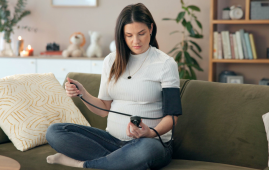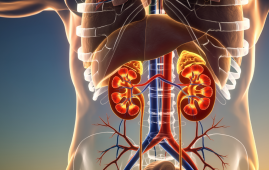

A team led by researchers from Mass Eye and Ear, a division of Mass General Brigham, reports the findings of a phase I trial of cultivated autologous limbal epithelial cell transplantation (CALEC), which was found to be safe and well-tolerated in four patients with significant chemical burns in one eye. According to a study published on August 18 in Science Advances, the patients who were tracked for a year had restored cornea surfaces, with two able to receive corneal transplants and two reporting significant improvements in eyesight without extra therapy.
While the phase I study was intended to determine preliminary safety and feasibility before moving on to the second phase of the trial, the researchers believe the preliminary results are promising.
Ula Jurkunas, MD, associate director of the Cornea Service at Mass Eye and Ear and an associate professor of ophthalmology at Harvard Medical School, was the study’s principal investigator and lead author. He mentioned that “Our early results suggest that CALEC might offer hope to patients who had been left with untreatable vision loss and pain associated with major cornea injuries,”
He also added that “Cornea specialists have been hindered by a lack of treatment options with a high safety profile to help our patients with chemical burns and injuries that render them unable to get an artificial cornea transplant. We are hopeful with further study, CALEC can one day fill this crucially needed treatment gap.”
In CALEC, stem cells from a patient’s healthy eye are extracted via a tiny biopsy and then multiplied and grown on a graft using a new manufacturing process at Dana-Farber Cancer Institute’s Connell and O’Reilly Families Cell Manipulation Core Facility. The CALEC graft is returned to Mass Eye and Ear after two to three weeks and put into the eye with corneal injury.
Jurkunas and colleagues at the Cornea Service at Mass Eye and Ear, researchers at Dana-Farber Cancer Institute led by Jerome Ritz, MD, Boston Children’s Hospital lead by Myriam Armant, Ph.D., and the JAEB Center for Health Research collaborated on the CALEC project.
Using one’s own stem cells to overcome limitations in current treatments:
Chemical burns and other eye traumas can cause limbal stem cell deficit, which is an irreversible loss of cells on the tissue surrounding the cornea. These individuals have permanent vision loss, as well as pain and discomfort in the affected eye. Patients are unable to undergo artificial cornea transplants, the current standard of vision rehabilitation, without limbal cells and a healthy eye surface.
Existing treatment strategies have limitations and risks that the CALEC procedure aims to address by using a small amount of a patient’s own stem cells, which can then be grown and expanded to create a sheet of cells that serves as a surface for normal tissue to grow back.
Despite landmark studies describing an autologous stem cell approach over the last 25 years and similar methods being used in Europe, no U.S. research team had successfully developed a manufacturing process and quality control tests that met U.S. Food and Drug Administration (FDA) requirements or demonstrated any clinical benefit, according to the authors.
Ritz, executive director of Dana-Farber’s Connell and O’Reilly Families Cell Manipulation Core Facility and professor of medicine at Harvard Medical School, stated “It was challenging to develop a process for creating limbal stem cell grafts that would meet the FDA’s strict regulatory requirements for tissue engineering,”
He also added that, “Having developed and implemented this process, it was very gratifying to see encouraging clinical outcomes in the first cohort of patients enrolled on this clinical trial.”
Cell therapy holds great promise for curing incurable diseases, according to these studies. The Gene and Cell Therapy Institute at Mass General Brigham is assisting in the translation of scientific discoveries generated by researchers into first-in-human clinical trials and, ultimately, life-changing treatments for patients. The Institute’s comprehensive approach distinguishes it from others in the field, assisting researchers in swiftly developing innovative therapeutics and pushing the technological and clinical frontiers of this new frontier.
As clinical trials progress, case studies show early promise:
Five individuals with chemical burns to one eye were enrolled and biopsied in the phase I study. Four patients got CALEC; a battery of quality control tests revealed that the cells in the fifth patient were unable to grow sufficiently. The CALEC patients were followed for a year.
The first patient treated, a 46-year-old man, had his eye surface defect resolved, paving the way for him to get an artificial cornea transplant for visual rehabilitation. The second patient, a 31-year-old male, had total symptom relief, with eyesight improving from 20/40 to 20/30.
The third patient, a 36-year-old male, had his corneal defect repaired and his vision improved from hand motion (only seeing broad movements like waving) to 20/30.
The fourth patient, a 52-year-old man, did not initially have a successful biopsy that resulted in a viable stem cell graft. He got a successful transplant three years later after re-attempting CALEC, and his vision improved from hand motion to being able to count fingers. He was then fitted with an artificial cornea.
The researchers are nearing the end of the second phase of the clinical trial, which will follow 15 CALEC patients for 18 months to further establish the procedure’s overall efficacy. Their objective is that CALEC will one day be a therapeutic option for people who have previously had to live with long-term disabilities because existing treatment choices were ineffective due to the severity of their injuries.
more recommended stories
 Phage Therapy Study Reveals RNA-Based Infection Control
Phage Therapy Study Reveals RNA-Based Infection ControlKey Takeaways (Quick Summary) Researchers uncovered.
 Pelvic Floor Disorders: Treatable Yet Often Ignored
Pelvic Floor Disorders: Treatable Yet Often IgnoredKey Takeaways (Quick Summary) Pelvic floor.
 Urine-Based microRNA Aging Clock Predicts Biological Age
Urine-Based microRNA Aging Clock Predicts Biological AgeKey Takeaways (Quick Summary) Researchers developed.
 Circadian Control of Neutrophils in Myocardial Infarction
Circadian Control of Neutrophils in Myocardial InfarctionKey Takeaways for HCPs Neutrophil activity.
 E-Cigarette Use and Heart Attack Risk in Former Smokers
E-Cigarette Use and Heart Attack Risk in Former SmokersKey Takeaways for Clinicians and Nurses.
 36-Week Pre-eclampsia Screening May Reduce Term Risk
36-Week Pre-eclampsia Screening May Reduce Term RiskA New Preventive Strategy for Term.
 Cardiovascular Risk and Sudden Cardiac Death in Diabetes
Cardiovascular Risk and Sudden Cardiac Death in DiabetesRising Sudden Cardiac Death (SCD) Risk.
 Poor Kidney Function and Alzheimer’s Biomarkers Explained
Poor Kidney Function and Alzheimer’s Biomarkers ExplainedPoor kidney function may influence levels.
 Walking Speed Before Hip Replacement Predicts Recovery
Walking Speed Before Hip Replacement Predicts RecoveryNew Evidence Points to a Simple,.
 Neuroblastoma Drug Combo Extends Survival in Models
Neuroblastoma Drug Combo Extends Survival in ModelsA Promising Shift in High-Risk Neuroblastoma.

Leave a Comment